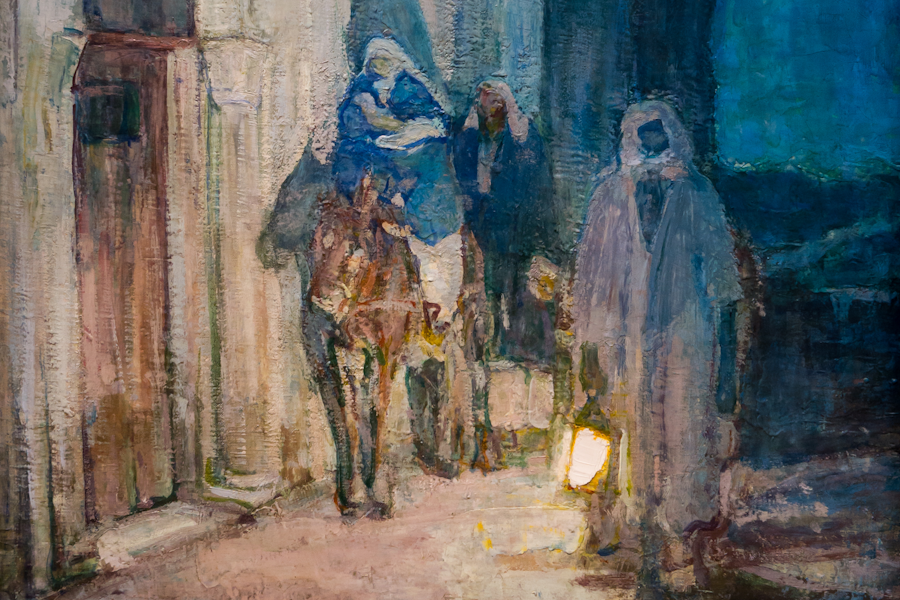“Take the child and his mother and escape to Egypt”1 was God’s urgent message to Joseph. Have you ever considered the impact that being a refugee had on young Jesus?
Just imagine: the shock of being awakened early and rushed out of the house; a physically difficult journey — around 400 miles — clouded in uncertainty; overhearing tidbits about the threat to your life and the massacre in your old neighborhood; reaching a foreign territory filled with unfamiliar faces speaking a strange language.
Current research on childhood trauma shows that events like this affect children physically and emotionally, no matter their age or whether they remember it consciously or not.2 While we don’t know the details of how this trauma affected Jesus, at the very least we can assume this was part of the human vulnerability God the Son willingly entered.
“We don’t have a priest who is out of touch with our reality. He’s been through weakness and testing, experienced it all.”3 One wonders how this part of Jesus’ life put him “in touch” with the human condition, specifically with the hardships of displaced or unwelcome people — people, past and present, who, for various reasons, long for safety, security, and belonging.
Are we in touch with that reality? It might require effort on our part to connect with the experiences of such people — to align ourselves with God’s concern for their wellbeing.
Consider the refugees fleeing the threatening or intolerable situations in South and Central America now living on the borders of the United States. How might our perspective change if we imagined Jesus were one of the children among them? In essence this is the reality: “Whatever you did for the least of these…you did for me.”4
Refugees are not the only dislocated people. The elderly in nursing homes have been uprooted from familiar surroundings and separated from their families. Children on the streets in every major city have fled intolerable home situations. A large number of young people who have not left their physical homes are victims of abuse, neglect, or emotional abandonment. In my counseling work I see how these children often seek refuge in drugs, sex, or suicide. Though the circumstances look different, people who are emotionally abandoned are also longing for “home” — for a place of safety and belonging.
In biblical times, the locus of refuge and security was the household, or bet’ ab. A household in those days was defined as “the patriarch, his wife, his unwed children, and his married sons with their wives and children…this extended family shared their resources and their fate.”5 Belonging to a household was essential for an individual’s survival, which is why the Bible narrative has many stories and prophecies that show God’s special concern for those “on the outside”: widows, orphans, and aliens. These three are mentioned together often in Scripture. They lacked the “normal circle of provision and protection.”6 This reality lies at the heart of the prophetic refrain to care for these three populations.
Caring for “widows, orphans, and aliens” begins with seeing them. In order to recognize who they are in our current time and place, we need to translate ancient social categories. Who are the ones today lacking a place of security and belonging? We must remember the various ways displacement can look: those fleeing unbearable conditions around the globe, the homeless, the elderly alone in a nursing home, the teen on the street, or the child abandoned in their own house.
Next, we need to get in touch with the hardships displaced people face and allow this insight to move us to a caring response. Some of us may know what it feels like to lack safety and belonging. Others must become listeners and learners in order to gain a sense of what these folks are feeling and what they need. Authentic listening is an act of generosity and hospitality. We put aside our agenda to give our full attention to the other person. Fully attentive listening allows us, be it ever so slightly, to enter the other’s pain.
And finally, we need to respond as Jesus would to people who need safety, security, and belonging. How might we do this?
Remember the elements of the ancient patriarchal household: provision, protection, belonging. These are things we can begin to offer at the personal, individual, and community level. Local efforts are ineffective when laws or traditions keep us separated from vulnerable people. So our response must also include grand-scale efforts, like organizing with other compassionate people to advocate for just policies.
How else can we respond as Jesus did to dislocated people? We can bless them — individually, personally, intentionally.
Our world is filled with harmful and destructive words — words that curse others — and displaced people receive more than their fair share. Instead of cursing, we can bless. Dallas Willard offers this definition:
Blessing is the projection of good into the life of another. It isn’t just words. It’s the actual putting forth of your will for the good of another person. It always involves God, because when you will the good of another person, you realize only God is capable of bringing that.7
As a school-based counselor, I present gifts to all my graduating seniors. One of these is a Bible inscribed with a personalized blessing — my expression of the good I desire for this young person. I have had the honor of giving these gifts hundreds of times. But one student reacted in a way that I will never forget.
Maria’s home was loveless and emotionally abusive. She longed for a place of security and belonging.
At Maria’s graduation I gave her the Bible inscribed with my blessing, which began: Maria, know that you have been “fearfully and wonderfully made” and you are one of God’s special and wonderful works.
After reading the blessing, this guarded and emotionally reserved young lady wept and gave me a big hug. In retrospect, I realize this moment was the culmination of two years of creating a safe space for Maria by listening to her and being present with her. From this space I was able to speak a blessing to her that was a powerful counterpoint to all of the destructive words — the curses— that had filled her ears and scarred her heart.
As we seek to recognize and respond to people around us who need refuge, Jesus the refugee will help us. Trevor Hudson has taught me much about how to let Christ shape our concern and respond with love.8 Inspired by some of his suggestions, here are a few prompts for moving deeper into the Compassionate Life.
Reflect on a time when you have felt significantly out of place. What thoughts and emotions did the uncertainty of the situation produce in you?
- What is one practical step can you take during the next few days to grow in your awareness of and desire to care for the widow, orphan, and foreigner? A few ideas:
Visit a nursing home or a community youth center and sit with someone who needs a listening ear.
Invite an international student at a local college for coffee, with the purpose of allowing them to share their story with you.
Watch a documentary or movie that depicts the realities displaced people face. (Suggestions: Hotel Rwanda, Born in Syria, Barefoot Children, Wetback)
What services are offered to refugees in your area or around the globe? How might you support those who are providing hospitality to these people?
How might you join with others to encourage people in power to give welcome and protection to displaced people at or inside their borders?
Read Matthew 2. Let God speak to your heart as you read. Talk to God about the feelings, questions, and desires that arise as you spend time considering this episode from the earthly life of Christ.
- Matthew 2:13. ↩︎
- Robin Karr-Morse and Meredith S. Wiley, Ghosts from the Nursery: Tracing the Roots of Violence (NY, NY: The Atlantic Monthly Press, 1997), 39 – 40. ↩︎
- Hebrews 4:14 – 16 (The Message). ↩︎
- Matthew 25:40. ↩︎
- Sandra L. Richter, The Epic of Eden: A Christian Entry into the Old Testament (Downers Grove, IL: IVP, 2008), 26. ↩︎
- Ibid, 27. ↩︎
- Dallas Willard, Living in Christ’s Presence (Downers Grove, IL: IVP, 2014), 164. ↩︎
- Trevor Hudson, A Mile in My Shoes: Cultivating Compassion (Nashville TN: Upper Room Press, 2005). ↩︎
Artwork: Flight into Egypt by Henry Ossawa Tanner, 1923. Metropolitan Museum of Art.
Text First Published February 2022 · Last Featured on Renovare.org February 2022


